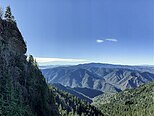
Back Tennessee de l'Est French Tennessee orientale Italian 동부 테네시 Korean East Tennessee SIMPLE 东田纳西 Chinese
East Tennessee | |
|---|---|
|
From top (left to right): Kuwohi in Great Smoky Mountains National Park, Neyland Stadium at the University of Tennessee, skyline of Knoxville, skyline of Chattanooga, Norris Dam and its reservoir, Oak Ridge National Laboratory, Sycamore Shoals State Historic Area | |
| Nickname(s): East TN, East Tenn. | |
 The counties of East Tennessee highlighted in red | |
| Country | |
| State | |
| Largest city | Knoxville |
| Area | |
| • Land | 35,115.8 km2 (13,558.27 sq mi) |
| Population (2020) | 2,470,105 |
| • Density | 70.34/km2 (182.18/sq mi) |
| Demonym | East Tennessean |
East Tennessee is one of the three Grand Divisions of Tennessee defined in state law. Geographically and socioculturally distinct, it comprises approximately the eastern third of the U.S. state of Tennessee. East Tennessee consists of 33 counties, 30 located within the Eastern Time Zone and three counties in the Central Time Zone, namely Bledsoe, Cumberland, and Marion.[1] East Tennessee is entirely located within the Appalachian Mountains, although the landforms range from densely forested 6,000-foot (1,800 m) mountains to broad river valleys. The region contains the major cities of Knoxville and Chattanooga, Tennessee's third and fourth largest cities, respectively, and the Tri-Cities, the state's sixth largest population center.
During the American Civil War, many East Tennesseans remained loyal to the Union even as the state seceded and joined the Confederacy. Early in the war, Unionist delegates unsuccessfully attempted to split East Tennessee into a separate state that would remain as part of the Union. After the war, a number of industrial operations were established in cities in the region. The Tennessee Valley Authority (TVA), created by Congress during the Great Depression in the 1930s, spurred economic development and helped to modernize the region's economy and society. The TVA would become the nation's largest public utility provider. Today, the TVA's administrative operations are headquartered in Knoxville, and its power operations are based in Chattanooga. Oak Ridge was the site of the world's first successful uranium enrichment operations, which were used to construct the world's first atomic bombs, two of which were dropped on Imperial Japan at the end of World War II.[2] The Appalachian Regional Commission further transformed the region in the late 20th century.
East Tennessee is both geographically and culturally part of Appalachia.[3] East Tennessee is home to the nation's most visited national park—the Great Smoky Mountains National Park—and hundreds of smaller recreational areas. East Tennessee is often considered the birthplace of country music, stemming from the 1927 Victor recording sessions in Bristol, and throughout the 20th and 21st centuries has produced a steady stream of musicians of national and international fame.[4]
- ^ "Tennessee Blue Book 2015–2016" (PDF). Nashville: Tennessee Secretary of State. 2015. p. 639. Retrieved June 5, 2021.
- ^ Siner, Emily (September 20, 2017). "How The U.S. Created A 'Secret City' In Oak Ridge To Build The Atomic Bomb, 75 Years Ago". WPLN-FM. Nashville. Retrieved June 5, 2021.
- ^ Abramson, Rudy; Gowen, Troy; Haskell, Jean; Oxendine, Jill (2006). Encyclopedia of Appalachia. Knoxville: University of Tennessee Press. pp. xix–xxv. ISBN 9781572334564. Retrieved July 23, 2021 – via Google Books.
- ^ Ted Olson and Ajay Kalra, "Appalachian Music: Examining Popular Assumptions". A Handbook to Appalachia: An Introduction to the Region (Knoxville, Tenn.: University of Tennessee Press, 2006), pp. 163–170.






